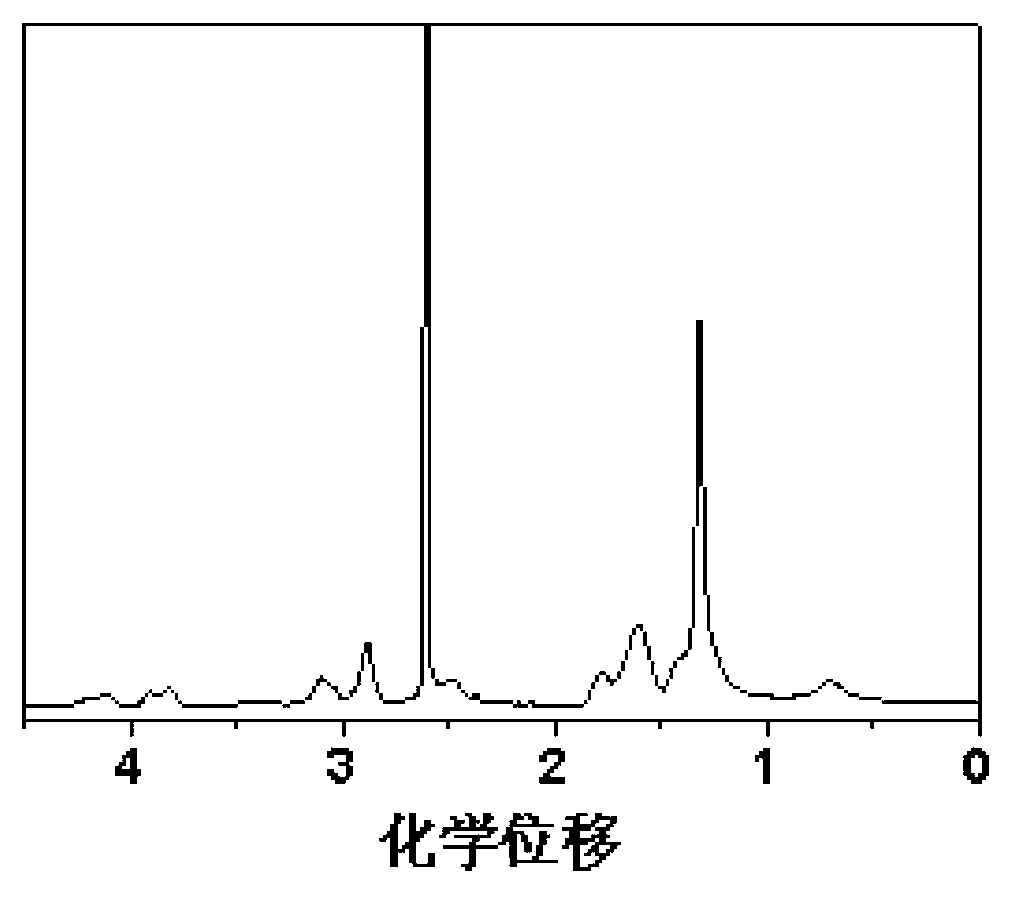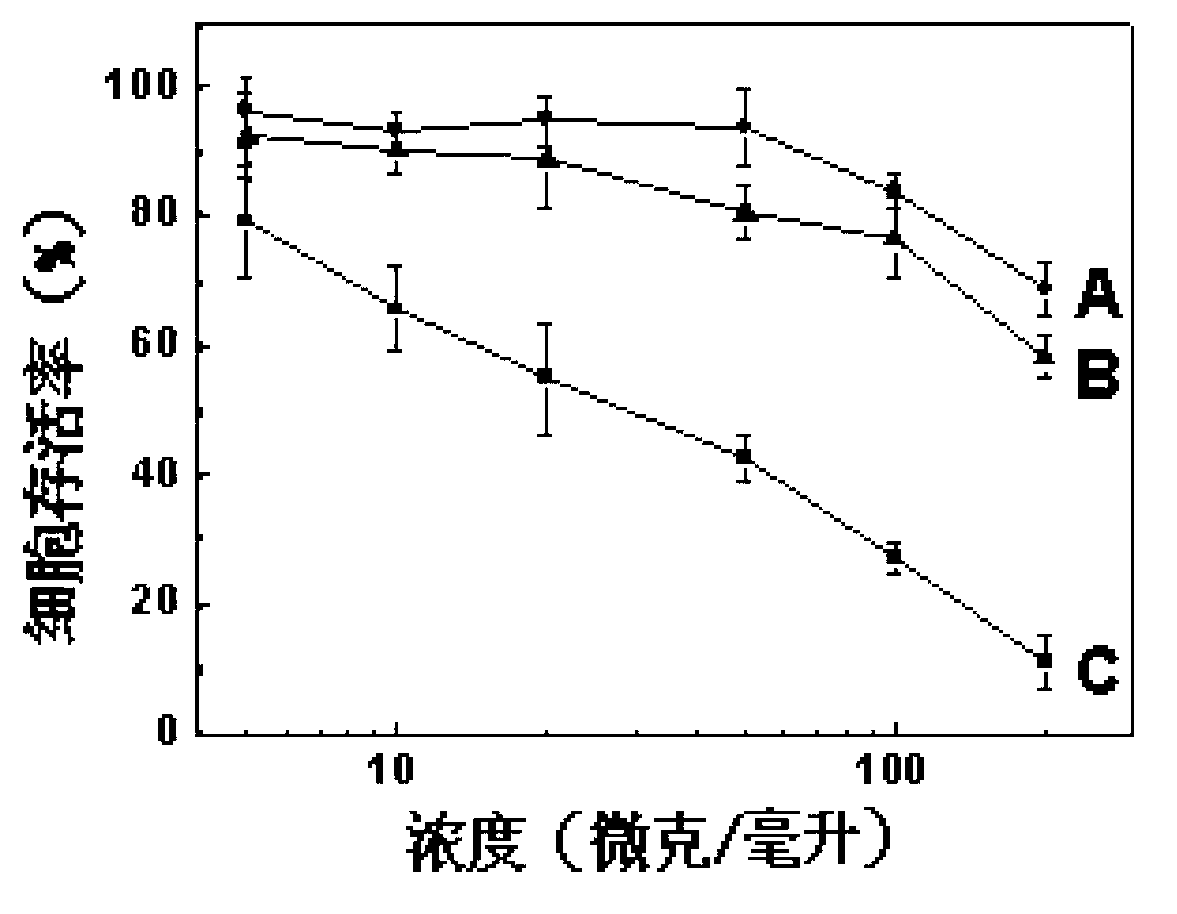Dendritic molecule-modified fluorescent quantum dots, and preparation method and application thereof
A fluorescent quantum dot and dendritic technology, applied in the field of biomedical engineering materials, can solve the problems of functional development and utilization of quantum dots (environmental response bottleneck, lack of modifiable groups, lack of stability of quantum dots, etc., to improve stability) Sexuality and biocompatibility, easy operation, and low toxicity of metabolites
- Summary
- Abstract
- Description
- Claims
- Application Information
AI Technical Summary
Problems solved by technology
Method used
Image
Examples
Embodiment 1
[0055] Example 1: Preparation of Dendrimer Modified Fluorescent Quantum Dots
[0056] (1) Synthesis of dendrimers whose end groups are siloxanes:
[0057] Weigh the second-generation polyamide-amine dendrimers (PAMAM-G2) containing terminal alkyne groups (synthesized according to the reference method (Journal of Materials Chemistry2011, 21:5273-5281)) and 3-mercaptopropyl trimethyl The base siloxane was dissolved in DMSO, and then the BPO initiator was added at 5°C. Nitrogen was passed through the mixed solution for 10-30 minutes to remove the air in the reaction system, and the gas flow rate was 5 L / min. Then sealed and reacted, magnetic stirring during the reaction, the rotating speed was 600 rpm; the reaction temperature was 90° C.; the reaction time was 4 hours. After the reaction is finished, the product is precipitated with anhydrous ether, washed once with acetone, and then vacuum-dried at room temperature to obtain polyamide-amine dendrimers whose end groups are silo...
Embodiment 2
[0062] Example 2: Preparation of fluorescent quantum dots modified by dendrimers
[0063] (1) Synthesis of dendrimers whose end groups are siloxanes:
[0064] Weigh the three-generation polyamide-amine dendrimer (PAMAM-G3) containing terminal alkyne group (synthesized according to the reference method (Journal of Materials Chemistry2011, 21:5273-5281)) and 3-mercaptopropyltrimethyl Siloxane was dissolved in DMSO, and AIBN initiator was added at 25°C. Nitrogen was passed through the mixed solution for 10-30 minutes to remove the air in the reaction system, and the gas flow rate was 0.5 L / min. Then it was sealed and reacted. During the reaction, it was stirred by magnetic force at a rotation speed of 1200 rpm; the reaction temperature was 40° C.; the reaction time was 12 hours. After the reaction finishes, the product is precipitated with anhydrous ether, and washed once with acetone, then the product is vacuum-dried at room temperature to obtain a polyamide-amine dendritic mo...
Embodiment 3
[0070] Example 3: Preparation of Dendrimer Modified Fluorescent Quantum Dots
[0071] (1) Synthesis of dendrimers whose end groups are siloxanes:
[0072] Weigh the four-generation polyamide-amine dendrimer (PAMAM-G4) containing terminal alkyne group (synthesized according to the reference method (Journal of Materials Chemistry2011, 21:5273-5281)) and 3-mercaptopropyltrimethyl The base siloxane was dissolved in DMSO, and then the MK initiator was added at 35°C. Nitrogen was passed through the mixed solution for 10-30 minutes to remove the air in the reaction system, and the gas flow rate was 2.5 L / min. Then sealed and reacted, the reaction system was placed under an ultraviolet lamp with an excitation wavelength of 365nm, the power was 400W, magnetic stirring was performed during the reaction, the rotation speed was 1000rpm, and the reaction time was 6h. After the reaction is finished, the product is precipitated with anhydrous ether, washed once with acetone, and then vacuu...
PUM
| Property | Measurement | Unit |
|---|---|---|
| particle diameter | aaaaa | aaaaa |
Abstract
Description
Claims
Application Information
 Login to View More
Login to View More - R&D
- Intellectual Property
- Life Sciences
- Materials
- Tech Scout
- Unparalleled Data Quality
- Higher Quality Content
- 60% Fewer Hallucinations
Browse by: Latest US Patents, China's latest patents, Technical Efficacy Thesaurus, Application Domain, Technology Topic, Popular Technical Reports.
© 2025 PatSnap. All rights reserved.Legal|Privacy policy|Modern Slavery Act Transparency Statement|Sitemap|About US| Contact US: help@patsnap.com



